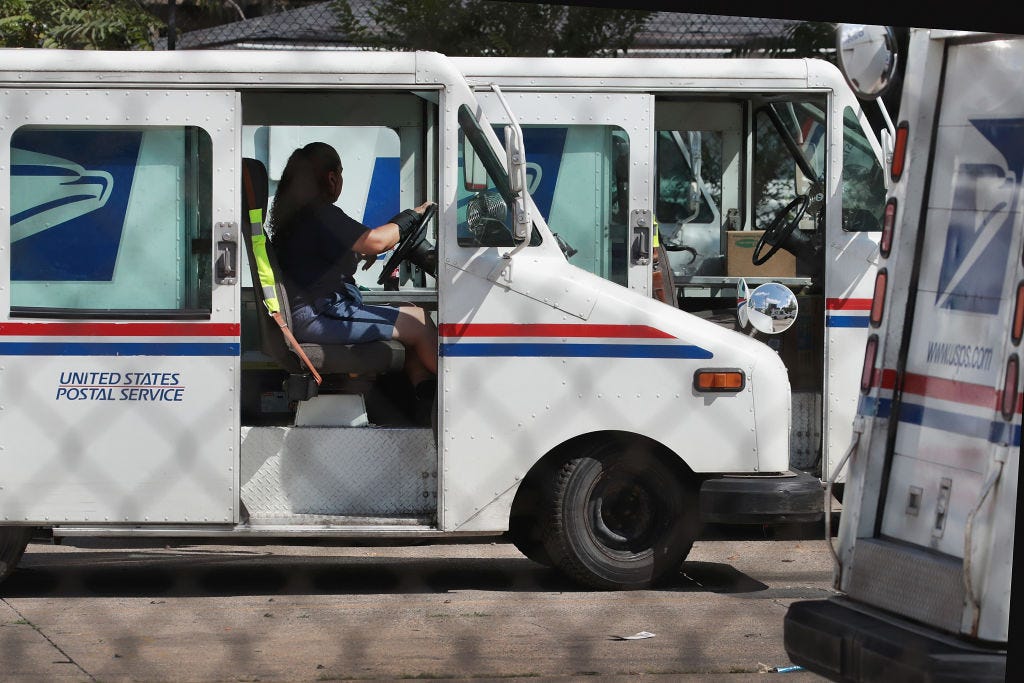
Regular mail service could be shut down as early as June, two US representatives said, and the effects could be disastrous.
Critical supplies — like the more than 1 billion shipments of prescription drugs delivered by the Postal Service last year — could be stuck, mail voting in the November election could be stymied, and hundreds of thousands of postal employees could be out of work, Reps. Carolyn Maloney and Gerry Connolly said in a statement on Monday.
“Based on a number of briefings and warnings this week about a critical fall-off in mail across the country, it has become clear that the Postal Service will not survive the summer without immediate help from Congress and the White House,” Maloney and Connolly said.
“Every community in America relies on the Postal Service to deliver vital goods and services, including life-saving medications. The Postal Service needs America’s help, and we must answer this call.”
The duo also introduced a bill that would provide $25 billion in emergency funding for the Postal Service while eliminating the agency’s debt and requiring it to prioritize medical deliveries.
The bill would also create temporary delivery points to protect workers. It’s not clear what these might look like, as the design would be left up to the Postal Service, but the bill’s language implies something similar to Amazon’s delivery lockers that allow people to send deliveries to a secure location other than their home.
Rep. Gerry Connolly
✔@GerryConnolly
Congress must not ignore the US Postal Service. Mail volume plummeted this week and USPS will run out of cash by June. Every household and every business in America relies on our postal service.
We can and should take swift action to return it to solvency or risk its collapse.
Like hospitals, grocery stores, and other essential businesses, post offices have remained open despite many businesses closing as the coronavirus continues to spread. As of Tuesday morning, more than 46,000 cases had been identified in the US.
At least 20 postal workers had fallen sick by Friday, The New York Times reported this week. The head of the National Postal Mail Handlers Union told the paper that workers had gotten sick in Miami, New York City, Seattle, Portland, and other cities.
That’s a small number of the agency’s roughly 630,000 employees, but it underscores the outbreak’s effects on several industries.
“These negative effects could be even more dire in rural areas, where millions of Americans are sheltering in place and rely on the Postal Service to deliver essential staples,” Maloney and Connolly’s statement said.
Latest news
- New York state health officials are resorting to an antiquated treatment to help patients recover from COVID-19: the blood of patients who have already recovered from the disease.
- The 2020 Tokyo Olympics will be postponed because of the coronavirus pandemic.
- Ford announced that it would work with 3M to produce respirators, GE to build ventilators, and the United Auto Workers to ramp up production of plastic medical face shields.
- Wuhan, China, the epicenter of the coronavirus outbreak, will end its uncompromising lockdown on April 8, allowing traffic to reenter and pass through the city.
- Microsoft is now the only company in the US with a market capitalization of more than $1 trillion.
- Trump is growing increasingly frustrated with Dr. Anthony Fauci, the leading US expert on infectious diseases, according to a New York Times report.
- The UK has gone into full lockdown, with the British public ordered to stay at home for up to six months.
- The Trump administration has released a 15-day plan to slow the spread of the coronavirus in the US.
- Spanish soldiers deployed to disinfect care homes around the country found elderly residents “completely abandoned,” with some left dead in their beds.
- The US Senate failed for a second time to pass a nearly $2 trillion stimulus package as Democrats urged more aid for workers affected by the coronavirus outbreak.
- US states including Ohio, New York, and California are ordering nonessential businesses to close. Here’s the difference between an essential and a nonessential business.
- Read live updates about case totals, death tolls, and new developments around the world. Here’s the latest on the escalating situation in the US.
Evolving research about COVID-19
- People older than 60 and those with preexisting conditions are at a much higher risk of severe illness and death. Experts have estimated that the virus’ overall death rate is 10 times as high as the flu’s.
- The most common symptoms are a fever and a dry cough, though some people experience headaches, nausea, vomiting, or diarrhea.
- Some people who get the virus seem to lose their sense of smell or taste.
- On average, a coronavirus patient infects at least two other people, but we can limit that spread with preventive measures.
- Though there are no approved treatments for COVID-19, researchers are racing to develop a vaccine and test drugs like a malaria pill called chloroquine.
How to stay safe
- The CDC has recommended “social distancing” to prevent person-to-person spread. Here’s what that means.
- These are the most effective hand sanitizers, cleaning products, and face masks to buy.
- The coronavirus can live on some surfaces for up to three days. Here’s how to properly clean your phone, home, and hands.
- Though very few children have been diagnosed with COVID-19, some can develop severe infections. Here’s how to keep your kids busy and safe, talk to them about the situation, and work from home while schools are closed.
- As the coronavirus outbreak forces more people to stay home, here are some options to entertain yourself and adjust to life under lockdown.











